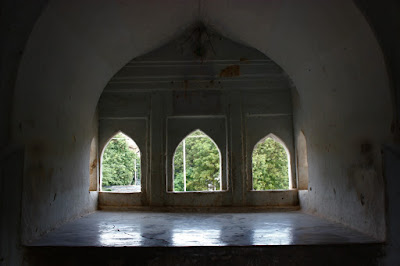A school time friend who's a builder posted a Whatsapp message about this beautiful temple some time 2016. Its unique look was captivating - its design was fresh and inspiring. A visit to Vennached was decided for sure. The shortest route from Hyderabad to Vennached is about 120 kms. Somehow a day trip never materialized. A trip to Dharwad was planned in August and we decided to touch Vennached on the way to Anegundi.
Aug 12, 2017
We left home early morning; took the ORR and exited at Telangana State Police Academy unction towards Vikarabad. The road was good excepting that passing through towns was slower than before because of ongoing road work. Soon we were at Ghadisingapur village; my plan was to turn left towards Dirsumpalli however a local person suggested us to go little further and turn left at Thunkimetla village. We were deep inside Telangana.. the countryside was interesting, a nice break from the concrete jungle we lived in. The road passed by several Lambani Thanda; we saw Lambani women in their traditional attire.. colorful skirts and blouses studded with mirrors and coins. Even their houses were unique.. the doors had colorfully painted frames. We reached Kosigi around 7-50; we stopped for breakfast and then resumed our journey. It was 8-30 when we entered Vennached. The temple is situated at the village square, the space around a 100 year old Neem tree.
So here we are looking at Vennached's Sai Mandir. What makes this structure unique is its perforated walls and Shikhara. These walls crate an enclosure yet connect the two sides- inside and outside. Light and air have plenty of ways to flow either ways. Adjoining the temple is a spacious platform partly shaded by the Neem tree. The design is neat and simple, giving it a classy look.
The temple is built on the traditional lines. It is east-facing, raised from the ground level, has a Pradakshina and a Shikhara. The temple has a high doorway like the doorway under a Gopura. The doors are wooden.
View of the Garbhagudi through the entrance.
The interior is simple and in lines with the exterior. However, people have cluttered the space with furniture. The temple design actually has provided the required utilities yet.. A family was participating in the Abhisheka ritual.
The walls are built in layers; the layers' thickness increases from bottom to top. The walls are made of red clay hollow bricks and grey stones called as Tandor stone. It seems like the designers wanted to keep use the least amount of cement as possible. Tandor stone, also known as Shahabad stones is a commonly used for building houses in Gulbarga district and surrounding places. The stones are used for walls, floors and roofs - not to mention shelves. You can see water tanks and benches too.
Closer look at a wall. The lower pradakshina. Its fun to see the game of light and shadows.
The building hasn't used much of paint. Only the columns and the hydro tower are painted.
Closer look at the bricks. My friend had remarked that building these walls wouldn't be easy work. From the looks of the quality, it needs skilled labor and careful supervision.
The temple platform for village meetings. The Neem tree too has a circular platform around it. Ample space for villagers to rest on. In fact, a small gathering was in progress; the rural electricity board meter reader was collecting dues.. a small crowd had gathered; everyone waiting for their turn.
The northern and eastern walls. The Shikhara is in Rekhanagara style, one of the styles that can be seen at Galaganatha temple at
Pattadakal. Its truly an amazing structure. Like our ancient temples, seems like this too will not require much of maintenance.
The rear wall. The walls seem like inviting people to visit the temple. At the right of this picture is the hydro tower. The builder has careful eliminated the use of fiber tank.
Building the Shikhgara would have a difficult task. It looks so symmetrical.. wonderful creation.
Sai Mandir and Neem tree. It is said that, at Shirdi, when Sai Baba as a young lad used to meditate under Neem tree.
As I was walking near the rear wall I happened to notice a lovely statue of Basaveshwara. It was a pleasant surprise. I knew about presence of Lingayath community in Telangana but I'd never seen any pictures or idols of Basaveshwara yet. So this confirms people here are familiar of Basaveshwara. The pedestal seems semi-finished. The statue was unveiled on May-19, 2013. Wondering if Basava's vachana's are known to Telugu speaking folks.. meaning have the vachanas been translated to Telugu?
Well, the visit to Vennached was worthwhile, I got a chance to see one of the most beautiful buildings. Simple, neat, beautiful and practical. Thanks to my friend Nag (CNN).
How to reach Vennached from Hyderabad.
- Hyderabad - Moinabad - Chevella - Manneguda - Parigi - Kodangal - Gadisingapur - Thunkimetla - Kosigi - Janampalli - Vennached.
- Hyderabad - Moinabad - Chevella - Manneguda - Parigi - Kodangal - Gadisingapur - Dirsumpalli - Mallepalli - Gumdal - Vennached (this route is slightly shorter)
- Hyderabad - Mahbubnagar - Mohammadabad - Janampalli - Vennached
.........


































































